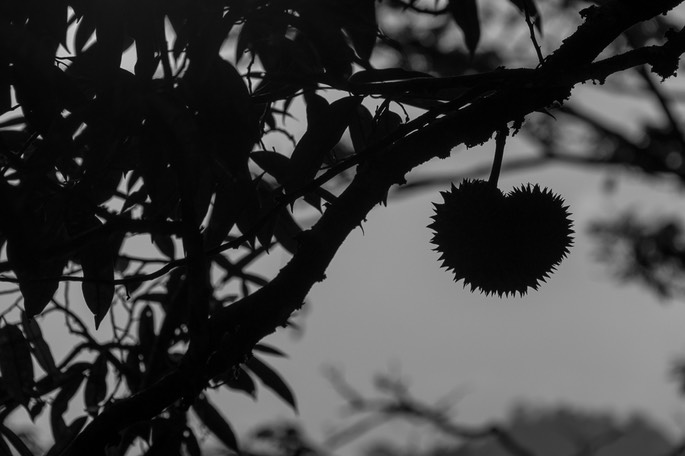
This year I found myself up in Janda Baik, Pahang, during durian season. There are several questions a foreigner gets asked in Malaysia; (1) can you eat spicy food, and (2) do you like durian? This fruit has such a pungent (unpleasant?) smell that it is banned from hotels and public transport in Malaysia and Singapore.
I was staying at Radiant Retreats, a company run by my friend Hanis Harun, prior to a trip to Taman Negara (see next blog). Her property has an old durian orchard and some of the trees were in bud.


Durian fruit are protected by a tough, hard, spiky coat which can split open when dropped from the great height of a durian tree. Without this, I think it must be almost impossible for animals to access the fleshy interior of this fruit.


Your can tell the species of durian by looking at the pattern of thorns at their base and the shape of the thorns themselves. We passed many stalls at the side of the road selling the Musang King variety, which is very popular. It helps to be able to identify your durian to make sure you are getting what you are paying for! They come in a huge variety of flavours, known only to the durian connoisseur, so I do not know the variety in Hanis’s orchard. If you enjoy eating durian, I would recommend you check out Lindsay Gasik’s book on The Durian Tourist’s Guide to Penang and her website which is full of durian facts.
Confession time; I do not like durian! But I do enjoy walking around Hanis’s orchard, especially in the golden light of a late afternoon.

There were other fruits here as well, such as this jack fruit which I love to eat. It grows closer to the ground than durians, so you don't risk getting hit on the head when walking near jackfruit trees. This fruit can grow up to about two feet in length and is very heavy. A Srilankan friend here in Johor Bahru once made me a curry of young, unripe, jackfruit which was delicious.

Here is a lime tree (below left)… you might start to think that fruits in Malaysia are all green-yellow in colour. But in the photo below right is a rambutan tree. When these furry fruits develop in a few weeks time, they will be a bright red and delicious when eaten fresh from the tree.


In July 2017 I helped Hanis plant an English garden in Janda Baik. Since then, she has planted some Bauhinia trees to provide some green coverage, and these at last have decided to flower. They are not English trees, but are popular in Hong Kong where the flower is Hong Kong’s national flower.


Janda Baik is just 45 minutes drive west from Kuala Lumpur and well worth a visit if you would like to spend some time in a rural Malay kampung in beautiful countryside. The hills are covered in primary rain forrest and you will be awakened by the sounds of birds and monkeys. Better still, because you are up in the hills (near Genting Highlands), the climate is cooler and fresher than down south in Johor Bahru.

Click here to return to Travels in Malaysia 2019.
Click here to return to Helen Gray’s homepage.